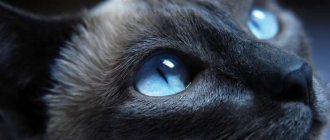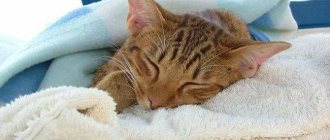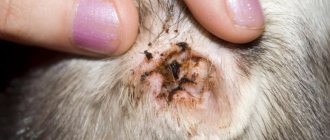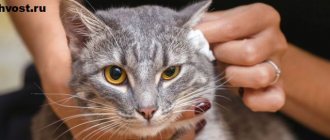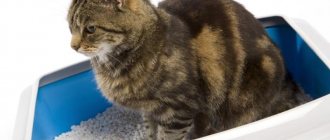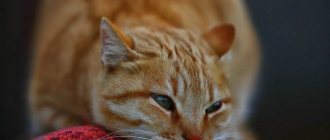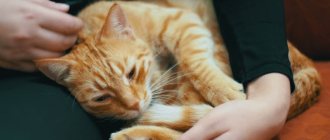It's funny when the cat sneezes, But runny nose in cats most often it is the cause of a cold, which does not pose a danger to the animal if treatment is started. But, unfortunately, in domestic cats, nasal discharge can indicate allergies and serious diseases. The correct diagnosis will be made by a veterinarian. Our article about the causes of a runny nose, what to do if cat sneezingt, types of nasal diseases accompanied by a runny nose, and how to treat an animal at home.
How to tell if your cat has a cold
Cats get colds for the same reasons as people get colds. Cats of any age can develop a runny nose. Hypothermia and drafts cause colds. If after bathing the cat was on a cold floor or in front of an open window and after that the cat sneezes, be sure that she has a common cold.
The causes and symptoms of colds in cats are as follows:
- increased body temperature (measured through the anus. Normal cat body temperature is 38 degrees).
- hot nose, ears, paw pads.
- The cat sneezes and coughs periodically.
- weakness.
- lack of appetite.
— the cat mostly sleeps.
Another additional symptom of a cold is watery eyes.
Treatment of colds in cats
When treating a cold for the first 24 hours, you can use traditional methods: provide the cat with warmth, food in the form of warm milk, vitamins, grass, and, if possible, massage her paws. This will increase blood flow, which will speed up recovery.
Clean your nose and eyes with a cotton pad. For this, chlorhexedine or a weak solution of potassium permanganate is useful.
We recommend rinsing your nose with one of the following options:
1. Novocaine 1% + Adrenaline.
2. Tannin 0.5%.
3. Ethacridine 0.2%.
4. Zinc sulfate – 2%.
If your eyes begin to fester and the nasal discharge changes in consistency, switch to the antibiotics Tobrex or Ciprofloxacin.
NEVER give your cat paracetamol. The composition of the medicine is toxic to cats and can cause severe internal bleeding.
Usually these measures help the animal overcome a cold.
What to do at home
Depending on the symptoms accompanying sneezing, it is possible to help the animal yourself.
Thus, dust ingress is the most harmless cause of a defensive reaction. High-quality cleaning or removing the animal from a dusty room can solve the problem. Keeping your home tidy will prevent foreign matter from entering your respiratory tract.
Green vomit in a cat
Dandruff
How to treat a cat with diarrhea and vomiting
If an allergy occurs, the first aid should be to remove the allergen from the animal. You can change the cleaning agent or choose a different type of filler. If there is a reaction to pollen, remove the flowering plant from the cat’s access, or remove the stamens in a timely manner. Usually these actions are enough to eliminate the negative impact.
As a preventative measure against colds that cause sneezing, you should give your pet multivitamins and feed him a balanced diet.
Any self-medication is dangerous for the cat; you should not postpone a visit to a specialist so as not to worsen his condition.
Symptoms and treatment of laryngitis
Laryngitis in cats is an inflammation of the laryngeal mucosa. It occurs due to hypothermia of the animal, feeding very cold or icy food, prolonged exposure to the cold, as well as chemical odors and smoke. Laryngitis can also be caused by allergies. We recommend not to make a diagnosis on your own and not to experiment with medications. Laryngitis accompanies rabies and tuberculosis, and the symptoms of the disease can easily be confused with calcivirosis and rhinotracheitis.
The disease is manifested by wheezing, difficulty swallowing, lack of appetite, weakness of the animal and prolonged sleep. Body temperature usually remains normal or slightly elevated. Sometimes vomiting appears after coughing - this is due to inflammation of the larynx.
Treatment: When the cat sneezes and coughs
Warmed food, water, milk, and broth will help cope with laryngitis. Do not give dry food - so as not to irritate the throat mucosa. Switch temporarily to feeding wet food or natural food.
Keep your pet warm - do not bathe him under any circumstances until he recovers, and do not expose him to drafts.
Bromhexine and mucaltin will cure a cat's cough.
If laryngitis is a consequence of allergies, the use of Diphenhydramine or Prednisolone is appropriate.
It is also appropriate to apply dry compresses (heated salt wrapped in cloth) to the cat's neck area.
To cure a runny nose in a cat, bury the nose with sea buckthorn oil - it has an antibacterial effect and heals the mucous membrane.
Treating a cat for sneezing
Only a veterinary specialist at the clinic can prescribe the correct treatment for a cat with symptoms of sneezing. If, during a clinical examination of your cat, a veterinarian determines that your cat is clinically healthy, he will recommend that you wet clean your apartment and use a special humidifier.
If the cause of sneezing is allergic in nature, then recommendations will be given to eliminate the allergen present in the apartment or to ensure that household chemicals are inaccessible to your cat. In order to alleviate the condition, a veterinarian will prescribe one or another antihistamine to your animal.
In the case where the cause of sneezing is polyps, it will be recommended to remove them surgically in a veterinary clinic.
If a cat's sneezing is accompanied by an asthmatic attack, antispasmodics, vasoconstrictors and corticosteroids are prescribed.
In case of diseases of the oral cavity (teeth, gums), a sick cat is given dental treatment, tartar is removed (tartar in cats), inflammation of the gums is relieved, and vitamins are prescribed.
If a helminthic infestation is detected in a cat during an examination, the veterinarian will prescribe special anthelmintic drugs.
If the cause of a cat’s sneezing is an infectious disease diagnosed in the clinic’s laboratory, then the sick animal will be prescribed antibacterial and antiviral drugs and immunomodulators.
The oncological cause of sneezing in a cat is eliminated by performing surgery to remove the tumor and prescribing a course of chemotherapy.
Rhinitis in cats
A runny nose in cats is most often caused by a cold. Rhinitis can also be the result of an allergy - to dust, perfume, air freshener or other household chemicals. If rhinitis is not treated, it becomes chronic - then it is dangerous due to the growth of polyps and adenoids. How can you tell if a cat’s runny nose is due to an allergy? The discharge is watery, sneezing is frequent. If there is an infection, the discharge becomes colored, becomes viscous and has a specific odor.
With rhinitis, a cat's nose becomes red, especially the edges of the nostrils, wheezing is heard when breathing, and with infections - lacrimation and the formation of crusts under the eyes.
How to cure rhinitis in cats
1. Regularly treat your eyes, remove crusts with a cotton swab moistened with chlorhexedine or saline solution.
2. If you have an infectious pathogen, drip your nose with Galazolin - 2 drops.
3. Rinse the spout with saline solution - dissolve 1 ml of salt in 100 ml of water. For administration, use a syringe without a needle or a pipette with a sharp tip.
4. Treatment of a runny nose in cats is carried out with a solution of adrenaline with 1% novocaine. Naphthyzin for children is also suitable .
5. A must for boosting immunity is Gamavit.
6. If the cat is given, do inhalation by adding 2 drops of eucalyptus to the steaming water.
7. In case of complications, give Dioxycycline according to the following scheme: 1st day, half a tablet per 1 kg of weight. The next 2 days - a tenth of a tablet per 1 kg of weight.
Fosprenil - 0.5 ml/kg. Course - 7 days.
Methods of treating the disease
Only a doctor can tell you how to treat a cat’s sneezing at home after examining your pet. In addition, a lot depends on the cause of the problem. The following is usually recommended:
- If the cause is allergies, antihistamines are prescribed;
- For colds, nasal rinsing, antibiotics and antiviral agents are prescribed;
- For a viral infection, antibiotics and anti-inflammatory drugs will help;
- For bacterial infections - probiotics and immunotherapy;
- For fungus - injection of antifungal agents directly into the nasal cavity;
- If a foreign body enters the nose, endoscopic removal and anti-inflammatory therapy should be performed if necessary;
- If you have asthma, it is recommended to use inhalers and glucocorticosteroids;
- For oncology, surgery, radiation or chemotherapy are indicated;
- Worms are treated with dewormers and vitamins.
Basically, the cause of sneezing lies in a cold, so rinsing is used for treatment at home. You need to do it like this:
- You need to warm the solution to room temperature;
- The liquid should be drawn into a thin syringe without a needle;
- It is necessary to securely secure the cat in a lying position or on its side using a towel;
- Next, you need to pour a little liquid into each cat’s nostril one by one, taking breaks so that he can get rid of the remainder;
- Upon completion of the procedure, the cat’s face should be blotted with a napkin.
Do not forget that all medications and procedures can be carried out only after diagnosis and consultation with a doctor. It is best to repeat manipulations with rinses, drops and tablets at the same time, calmly and without aggression. After this, you need to pet and reward the cat with a treat.
Other possible causes of a runny nose
1. Caries. An infection in the oral cavity penetrates the nasopharynx, causing inflammation of the mucous membrane. As a result, the cat sneezes, its nose runs, and its eyes water. In this case, you need to contact a veterinarian to eliminate the cause of the runny nose.
2. Worms. Helminths are insidious creatures that can also cause runny noses in cats. Regularly - once every 3 months - give your pet anthelmintic drugs. This must be done because The cat is constantly licking something - the floor, the walls, street shoes, etc.
3. Allergies. Observe the animal's reaction to the aroma of your cosmetics/deodorants - perhaps they irritate the mucous membrane of his nose. Try to regularly clean the house of dust - it also serves as a powerful allergen for cats.
What is "Sneeze"
Sneezing is a protective natural reaction of the body to the appearance of an irritant in the nasal passages. A long inhalation when sneezing precedes a sharp exhalation, due to which interfering particles leave the nasal passages.
This behavior is typical not only of cats, but of any animal. A single sneeze is not a cause for concern. However, if it occurs regularly, you should take care of your pet’s health.
There is no need to panic and take your cat to the veterinarian immediately. It is necessary to observe the animal’s behavior and determine the presence of accompanying symptoms. This will help the veterinarian determine the correct diagnosis and begin timely, appropriate treatment.
Associated symptoms
You should immediately show your animal to a doctor if, along with sneezing, the following clinical manifestations are observed:
- impaired breathing;
- the appearance of discharge of various types, bleeding from the nose;
- inflammation, swelling, discharge from the eyes;
- demonstration of aggression, anxiety, lethargy, previously not characteristic of the cat;
- refusal of food, water;
- dry mouth, unpleasant odor.
You should immediately take your animal to the veterinarian if he is drooling profusely, breathing heavily, or trying to hide in a secluded corner.
Preventive measures
In order to prevent harmless sneezing in a cat, the animal should be kept in a clean room and wet cleaning should be carried out regularly. Cleanliness in the house will protect your pet from foreign objects getting into the nasal cavity. In case of allergic sneezing, you should protect your pet from the influence of the allergen. An effective method of preventing infectious causes in cats is to vaccinate animals according to a schedule. It is necessary to monitor the condition of the pet’s mouth and teeth and regularly remove tartar. To prevent parasitic causes, the animal should be regularly subjected to deworming (destruction of worms) with special preparations.
Sneezing in a cat is a normal physiological process that helps keep the nasal cavity clean. The owner should pay attention to such a reaction if it is regular and multiple. The presence of other symptoms requires an immediate visit to a veterinarian.
Reverse sneezing:
While sneezing and snorting are expulsions of air from the nose/mouth, "reverse" sneezing is an involuntary, spasmodic inhalation that some dogs exhibit. Episodes of such abnormal breathing can last several minutes. It's not uncommon for a dog to do this after being walked and breathing something (dust, pollen, dirt) into its nose.
Many dog owners see reverse sneezing and initially assume their dog is choking or in crisis. While this is alarming to the uninitiated owner, there is nothing more to this condition than irritation of the tissues in the back of the throat and soft palate. This sign is completely benign. It can also occur with tracheal collapse.
A cat sneezes blood - how dangerous is it and what to do?
Blood indicates damage to the mucosa. They can be caused by a foreign body, progressive infection by bacteria or a virus. The nasal passage should be inspected; visible accessible particles (lint, wool) are removed without using tweezers. If lumps are detected, you should consult a doctor. They may indicate neoplasms.
Infections should be treated by a doctor. The breeder can only treat the nose with water or a wet soft cloth. You cannot wash the cavity yourself. If bleeding caused by scratching is detected, the pet is urgently taken to the veterinary clinic or a doctor is called to the house.
Be sure to read:
The kitten sleeps constantly: physiological and pathological reasons, what affects when to sound the alarm
Prevention
If the cat’s sneezing is harmless and caused by the presence of dust in the apartment, then the owners will need to keep their apartment clean and regularly carry out wet cleaning of the room. If sneezing is allergic, owners must protect their pet from the allergen (air freshener, perfume, perfume, washing powder, tobacco smoke, etc.).
An effective way to prevent the infectious component of cat sneezing is to vaccinate animals according to the existing schedule. Starting from six months, you need to follow the vaccination schedule and vaccinate them against: viruses; cat flu; leukemia and leukopenia; rabies.
Oral diseases are prevented by constant monitoring of the condition of the oral cavity and teeth, and timely removal of tartar.
Worm infestations in cats are prevented by regular deworming of the animal with anthelmintics.
The main thing is to undergo regular preventive examinations of your cat at a veterinary clinic in order to detect danger in time and begin timely treatment.
Eyes water when sneezing
Watery eyes during a sneeze can be caused by various factors. These symptoms are observed when:
- allergic reactions;
- colds and infectious diseases;
- the presence of parasites;
- oncology.
If there has been no contact with allergens, the animal is not hypersensitive; if such signs occur, you should consult a specialist. He will determine why the cat is sneezing, snorting and watery eyes, and will select the appropriate treatment.
Folk signs about cat sneezing
Kotofey in the house is the keeper of home comfort and a peaceful hearth. Our ancestors believed that the purr was a trusted brownie. And the one who pets a cat, strokes it and takes care of it, gets sick less. This is the truth - it has been proven that cats draw out negative energy from people, healing the owner’s body.
Among the people, cats were valued and revered. Slavic ancestors even acquired a house keeper, adhering to special signs: they did not buy the animal, but exchanged it for a chicken egg. A cat became a successful acquisition if its color matched the owner's hair color.
In this case, the brownie became friends with the new pet and defended the house doubly actively. If a domestic cat gave birth, a black baby was left in the house - it brought happiness, especially if it was born on Sunday. Why does your furry pet sneeze? What news does he bring?
- The cat sneezed during the wedding not far from the bride - the girl will have a happy and calm marriage.
- Kotofey sneezes non-stop - it calls for rain. If you go outside, take an umbrella. If, when sneezing, the purr stretches out its paws and yawns, there will be a long cold snap and inclement weather.
- If a fluffy sneezed on a person’s lap three times periodically, he warns about the illness of one of this person’s relatives. A single sneeze portends success and profit.
When the purr sneezed, do not forget to respectfully wish the furry creature “Big health.” According to legend, this adds health to the wisher. But if the purr sneezes on the weekend (Saturday, Sunday), you should make a wish - it will definitely come true!
Cat diseases
A single sneeze does not pose a threat to an animal (as well as to a person). But when the cat sneezes constantly, and at the same time additional symptoms appear, this is dangerous. This condition indicates the development of a pathological situation requiring specialist intervention. After all, it can be contagious to humans.
Colds
Modern people, moving at a frantic pace of life, are accustomed to not paying attention to minor colds. Pets have a different daily routine, but cats can also get sick. Colds in furry creatures are more severe and can lead to serious complications.
Causes of illness. Healthy and strong purrs are not afraid of colds - the animal’s immunity successfully copes with the disease. But, under the following circumstances, the immune system malfunctions, and the tailed animals get sick:
- Bad conditions. If the cat is in a room blown by cold winds, where there is dampness, he will definitely get acquainted with a cold.
- High humidity. A constantly high percentage of humidity leads the purr to the most dangerous cold complication - pneumonia. Pneumonia develops gradually in cats, and owners for a long time are not even aware of the mortal danger.
- Unhealthy diet. If there are no vitamins on the Kotofey menu, the diet is monotonous - this leads to a serious decline in immunity and the development of a cold.
- Air temperature. Fluffies are sensitive to temperature changes, fluctuations in which cause diseases. Optimal living conditions for a pet: +17-22⁰С in summer and +20-26⁰С in winter.
- Hypothermia. If a cat, while walking around the yard, gets caught in heavy, dank rain, expect a cold. In a wet pet, the process of thermoregulation is disrupted, causing the cat to instantly freeze.
This is interesting. A cat does not catch colds from humans, provided that the disease is caused by viruses. But when the human body is attacked by bacteria and fungi, the infection easily spreads from people to pets.
Symptoms. The symptoms of cat colds are similar to the symptoms of diseases in humans. Based on the physiological characteristics of felines, you can suspect that a cat has started to get sick based on the following signs:
- The nose is dry and hot.
- The fur loses its smoothness and beauty.
- A sick cat sleeps for an unnaturally long time (all day).
- The cat ceases to be interested in toys and does not go to the person.
- Behaves strangely: aggressiveness appears or fearfulness develops.
An inexperienced owner may confuse cold symptoms in furry cats with manifestations of serious complications. You should know how a purr with a cold behaves:
Weakness. If your cat has a cold, he shouldn't lie down all the time. Even a cat with a cold finds the strength to stand and walk on its paws. When a cat has a cold, it quickly gets tired, but signs of complete apathy indicate the development of serious illnesses.
Runny nose. When a cat has a cold, it starts to become snotty. This phenomenon is normal; the body removes obsolete microorganisms and leukocytes through mucus. When cats have a runny nose, nasal breathing is difficult (the nose is clogged), so cats with a cold occasionally breathe through their mouths.
The owner should be wary when the cat completely switches to mouth breathing. Licking, constantly snorting and coughing is a sign of the development of a serious illness.
When you have a cold, snot flows liquid and transparent. If the nasal discharge has changed color (purulent, green snot), do not hesitate to visit the veterinarian! Coughing and excessive sneezing are a natural manifestation of a cold, this is how the cat clears congestion in the nasal passages.
But when the animal is snotty to such an extent that the fur on its face sticks together (even when the purr is regularly licked). And a runny nose becomes chronic - this indicates the development of a serious complication.
Appetite. When cats have a cold, they lose their appetite and are able to go without food for several days, but they drink a lot. It is not worth forcing or persuading an animal to eat; it is better to offer a low-fat broth to a cat with a cold. If the hunger strike continues for more than 2-3 days, a doctor’s consultation is required.
Eye condition. Red eyes are a rare symptom of cat colds. Redness of the sclera when a cat has a cold indicates high blood pressure. Hypertension is a common companion to colds; this condition is treated separately.
Temperature. Purrs do not have a stable body temperature; in a healthy cat, its values are +37.5-39⁰C, regardless of breed. Representatives of the hairless species feel hotter to the touch due to the lack of hair.
At the first sign of a cold, take your purr to the vet. A cat cold progresses quickly and leads to a deadly complication - pneumonia. Home treatment is allowed only in the stages of a mild runny nose.
What to do at home. Provide peace and warmth, especially during the cold season. Move the sick pet's bed to a warm room and lift it off the floor. Use a thick terry towel or a woolen blanket for bedding (put a heating pad in the bed if the cat is shaking). Give your cat plenty of drink - warm milk.
Massage will be a good help in curing a cold. Lightly stroking the animal’s body increases blood circulation and helps the body cope with the disease.
Viral infections
Pathological processes of an acute nature, in the development of which pathogenic microorganisms participate. It’s not for nothing that the word “virus” translated from Latin means “poison.” Viral diseases are deadly and pose a threat to humans as well. In domestic purrs, infectious diseases are fatal (if not treated promptly).
Causes of illnesses. More often, the culprits of infections are sick animals or carriers of dangerous microbes (viral cells spread in such individuals along with secretions: feces and urine). A viral infection enters a cat's body by inhaling or eating contaminated food.
Pathogenic agents quietly wait in the wings on the animal’s toys, bedding, and toilet. The owner brings them with him from the street. The spread of viruses is facilitated by lack of basic hygiene. Poor nutrition of the pet, severe stress and hypothermia affect it.
Symptoms. There are many viral diseases and unhappy purrs. They all have their own symptoms. But there are a number of common signs of infection:
- Severe weakness, apathy towards everything.
- High body temperature (above +39⁰ C).
- Problems in the gastrointestinal tract (pet diarrhea, vomiting).
- Excessive snot, lacrimation, suppuration of the eyes.
- Changes in appearance (dull, tousled coat).
- The pet does not eat or drink at all, meows pitifully, and continuously sneezes.
Not all diseases of this etymology cause increased sneezing during viral infections. This reaction occurs when:
Rhinotracheitis. Chronic runny nose, which has progressed to the stage of pathology. The disease is provoked by viral groups (capici- and reoviruses). Once in the body, after 2-4 days the bacteria penetrate the eyes, respiratory organs and nasopharynx of the animal. The complicated disease progresses to pneumonia and keratoconjunctivitis. The disease is accompanied by:
- Photophobia.
- Severe cough.
- Purulent discharge from the nose and eyes.
During treatment, the veterinarian prescribes Gamavit and Maksidin. In mild cases, fluffies are prescribed special serums and antibacterial medications. With timely treatment, rhinotracheitis can be completely cured.
Calcivirosis. General damage to the respiratory tract of cats. Bacteria enter the body through airborne droplets and actively occupy the tonsils and nasal mucosa. After 2-5 days, the symptoms of the disease clearly appear:
- Chills.
- Conjunctivitis.
- Severe runny nose.
- Heat.
- Pallor of the mucous membranes.
- Inflammation of the mouth, tongue and lips (appearance of ulcers).
The disease provokes the appearance of tracheitis, pneumonia and bronchitis. Doctors prescribe an antibacterial attack with Maxidin, Fosprenil and Gamavit. In the early stages of the disease, Vitafel and Aminovit are effective.
Cat flu. A disease of the upper respiratory tract of cats that does not pose a threat to humans. Viral strains infect the animal's nasopharynx, gradually moving into the pulmonary system and causing the development of pneumonia. The flu develops within 2-3 days.
This is a dangerous infection that leads to the death of kittens and (in 92% of cases) adults. In addition to sneezing, cat flu manifests itself with the following symptoms:
- Coughing up blood.
- Feverish state.
- The cat constantly opens his mouth.
- The pet's eyes and nose fester.
- Swelling of the nasopharyngeal mucosa.
The disease is difficult to cure. In therapeutic measures, veterinarians prescribe powerful antibacterial drugs. Particular attention is paid to caring for a sick animal and completely protecting the pet from hypothermia and drafts.
Attention! Viral diseases of furry pupils are a serious and dangerous phenomenon. In each specific case, veterinarians develop an individual therapy program. Do not self-medicate, but hurry up and visit a doctor!
A reliable measure to protect your beloved purr is annual vaccination, which reliably protects your pet from viral infections. And remember that viruses pose a mortal threat to both the animal and its owner.
The culprit of sneezing is allergies
Allergic manifestations affect 2/3 of the world's population. Allergies do not spare your favorite purring pets. According to the observations of veterinarians, allergic reactions are the most common reason for worried owners to appear to doctors.
The mechanisms of development and occurrence of allergies in cats are similar to those in humans. But it is strictly forbidden to give human antihistamines to purrs - cats react differently to human medications and the allergy can worsen.
The culprits of the pathology. Almost any substance appears as an allergen in purrs (it is difficult to identify the irritating factor). But it has been noticed that cats more often react to:
Food. Chocolate, eggs, dairy products, and corn lead to allergic reactions. Red vegetables and fruits, poultry and beef. Allergies are provoked by prolonged use of poor quality dry food.
Insects (fleas, mosquitoes, ticks, lice eaters). The cat reacts to parasite bites, their secretions, saliva (she scratches her ear, belly - where the parasite bit). Just one pest bite can cause a severe allergic reaction.
Houseware. In purrs, allergies manifest themselves from dust, cosmetics and cleaning products, litter, pollen and house plants. To do this, the cat just needs to inhale the allergen or stick his paw into the powder so that the immune system gives an inadequate reaction.
Symptoms. Allergic symptoms do not depend on the type of irritant. The pathology manifests itself equally in all cases. With allergies, cats experience:
- Severe body itching. More often the animal scratches its belly, neck, head and inner thighs.
- Skin rashes. Skin manifestations range from slight redness to severe itchy scabs.
- Problems with the respiratory system. The sick animal breathes heavily (wheezing is observed) and sneezes heavily. The purr's eyes become swollen and watery. The pet does not eat well due to swelling of the pharynx.
If an itchy rash appears, monitor your pet carefully. The cat, in the hope of quelling the unbearable itching, scratches itself into wounds where pathogenic microflora easily penetrates. Microbes provoke the development of severe inflammation and the formation of deep ulcers.
Allergy is a very serious pathology! Don't expect the cat to go away on its own. The veterinarian, based on the analyses, develops therapeutic control measures. The course consists of taking special antihistamines for animals and using steroids.
Feline asthma
One of the most dangerous and difficult to treat pathologies in purrs, in 80% of cases leading to the death of pets. There is no permanent cure for asthma in cats. With proper treatment, owners achieve only periods of remission, minimizing the symptoms of the disease.
The culprits of the disease. The causes of the dangerous pathology have not been fully identified. Asthma is a sharp narrowing of the bronchi that stops breathing. During an attack, swelling of the bronchial wall occurs and abundant mucus appears.
Veterinarians are inclined to believe that the main culprit in the development of asthma in cats is allergies. The disease awakens when a certain concentration of allergens accumulates in the cat's body. Choking attacks in animals occur every day, but can bother your pet 2-3 times a year.
Symptoms. Asthma's manifestations are similar to infestation with parasites, manifestations of bronchitis and pneumonia (any disease that occurs with severe sneezing, coughing and asthma attacks).
During an attack, the cat stretches its neck forward, its mouth is constantly open (when, after prolonged sneezing and coughing, the cat becomes hoarse, it begins to breathe through its mouth). In severe cases, the animal wheezes, loses consciousness, the lips and eyelid area turn blue (the pet does not breathe).
How the disease is treated. During an attack, the pet must be immediately taken to the veterinarian (make sure that the weakened animal does not show aggression, this often happens). The owner needs to act confidently and calmly, without unnerving the purr.
After tests and studies, therapy is prescribed in the form of taking bronchodilators and glucocorticosteroids. If a pet has asthma, the owner is advised to purchase a special inhaler (for animals) and protect the pet from the allergen:
- Clean your apartment thoroughly from dust.
- Hide household chemicals and cosmetics in closed containers.
- Adjust your pet’s diet (replace dry food with nutritious food).
Ventilate the room more often, do not smoke in front of the animal and do not let your cat go for a walk alone (attacks can happen at any moment). It is important to prevent a cat with asthma from becoming overweight. Being overweight makes the situation worse.
Sneezing due to dental problems
Kitties are predisposed to diseases of teeth and gums (even tiny kittens suffer from this). In total, cats grow 30 teeth. What is the connection between sneezing and dental pathologies?
The processes of inflammation occurring in the oral cavity quickly spread to the nasopharynx. Because of this, the pet sneezes heavily and constantly, rubbing its face with its paw. Kotofey is snotty and refuses to eat. The purr's breath smells unpleasant. What dental problems does your furry pet face?
Plaque. The most common dental disease in cats. In the oral cavity, a layer of dark plaque forms on the teeth. This is a complex problem that even an experienced doctor is not always able to get rid of. The plaque is removed in the clinic under anesthesia. The following recommendations will help you avoid the problem returning:
- Use a special brush for animals (but not all cats will allow the owner to clean their mouth).
- Add medicinal supplements to the water your animal drinks. They stop the appearance of plaque. But scrupulous purrs may refuse to take such water.
What to do? It has been noticed that cats fed dry food are less likely to encounter this unpleasant problem. Give your pet more dry food, but of good quality (Premium class).
Gingivitis. The origins of this serious disease lie in dental plaque. Over time, these teeth become inflamed and painful, and the gums become red and swollen. The disease is accompanied by a strong, repulsive odor from the mouth. A sick animal drools and refuses to eat. Gingivitis develops even in young cats during the change of teeth (5-6 months of life). To cure an animal, you will need to remove tartar, polish and remove diseased teeth.
There are three other dental diseases that cause increased sneezing in cats. These diseases develop rarely:
- Periodontitis. Inflammatory pathology of gingival tissue. The symptoms of the disease resemble gingivitis. The gums soften, exposing the teeth, and fester. All diseased teeth must be removed.
- Stomatitis. Inflammatory process of the oral cavity. A very painful condition in cats. The poor purrs refuse to eat and suffer greatly. In the treatment of stomatitis, antibiotics are used, and diseased teeth are pulled out.
- Resorptive inflammation. The disease develops in adults (over 5-6 years old). All infected teeth from a sick animal are removed. If this problem is not addressed, the disease affects the roots of the tooth and the cat loses its entire dentition.
If a pet loses its teeth, it can live peacefully without them - after all, it does not need to hunt. But, in order to prevent the animal from suffering, a loving owner should regularly check the condition of the animal’s oral cavity with a veterinarian and not allow it to develop painful pathologies.
Sneezing due to worms
Uninvited guests-parasites provoke a bunch of reasons that cause a severe runny nose. Sneezing, runny nose, coughing due to helminths is a combination of three problems at once:
- Irritation of the mucous membrane of the nasopharynx.
- Development of infectious conditions due to decreased immunity.
- Allergic reactions (hypersensitivity) to the activity of parasites.
Worms, “travelling” through the body, enter the cat’s nose, causing a severe runny nose and sneezing.
How does a cat become infected? Kotofey about when eating raw meat/fish, quenching thirst from a dirty puddle, sniffing foreign excrement. After walking down the street and returning home, the cat cleans its dirty paws by licking them and becomes infected with worm eggs.
A pet with helminthiasis transmits parasites to humans through saliva or feces (when the owner cleans the cat litter box).
Symptoms. Kotofey, having become infected with worms, becomes lethargic, apathetic, and weak. The fur of a sick animal loses its smoothness and shine. The pet suffers from gastrointestinal problems (constipation, diarrhea).
Parasites cause appetite disturbances (loss or excessive desire to eat). Eating greedily and a lot, the sick animal loses weight, and its stomach bulges, becoming tight, like a ball. A swollen abdomen indicates an intestinal blockage. This situation is deadly - if the intestines rupture, the animal dies.
Parasites, feeding on blood, lymph, and tissues of internal organs, cause irreparable harm to the health of the animal. Dead worms poison the body with decay products, causing poor health and serious allergic reactions. You should get rid of the arrogant creatures immediately!
Methods of struggle. The necessary anthelmintic drugs are prescribed by the veterinarian after tests have been carried out and the type of parasite that has occupied the pet has been determined. Do not self-medicate, but follow the doctor's instructions! On his own, the owner can only try to protect his beloved furry from infection in the following ways:
- Regularly give the animal complex anti-parasite remedies. For domestic cats that do not walk outside - once every 3-4 months. For free-ranging pets – once every 2-3 months.
- Get vaccinated. Antiparasitic agents in the form of a suspension are given to small kittens at the age of 2.5-3 weeks, 1.5-2 weeks before the scheduled vaccination.
The best antiparasitic agents are pyrantel, canikquantel, drontal, prazicide and profender. Adult cats are given the drug 2-2.5 weeks before vaccination and 2 weeks before mating.
Preventive measures include increasing the level of hygiene: timely cleaning of the cat litter box. Remember to wash your hands thoroughly after cleaning up used litter. Exclude raw fish and meat from your fluffy's menu.
The cause of sneezing is tumors
Nasal polyps are a common culprit for a pet's uncontrollable sneezing. New growths interfere with air exchange and cause discomfort. To identify polyps, you should contact your veterinarian. The doctor, under general anesthesia, will conduct a study to determine the malignancy of the tumors.
A sign of nasal cancer is sneezing with bloody mucus. But blood appears when sneezing and due to a foreign object. A foreign body (toys, threads, pieces of food, buttons) injures the sensitive nasal tissue.
Predisposing factors to the formation of polyps are chronic runny nose and prolonged inflammation of the nasopharynx in the animal. The polyp cannot always be seen - sometimes the tumor grows inward, without protruding from the nostril. The owner should be wary of the following factors:
- Copious snot.
- Increased wheezing when breathing.
- Severe, prolonged sneezing.
- Mouth breathing due to the animal not breathing.
The pet tries to remove the disturbing object. The cat cranes its neck, shakes its head and vigorously rubs its nose with its paw.
To get rid of the polyp, the veterinarian resorts to surgical methods. After surgery, the pet undergoes a course of antibiotics. A weakened cat's body should be supported by taking general strengthening agents. All medications are prescribed only by a veterinarian!
